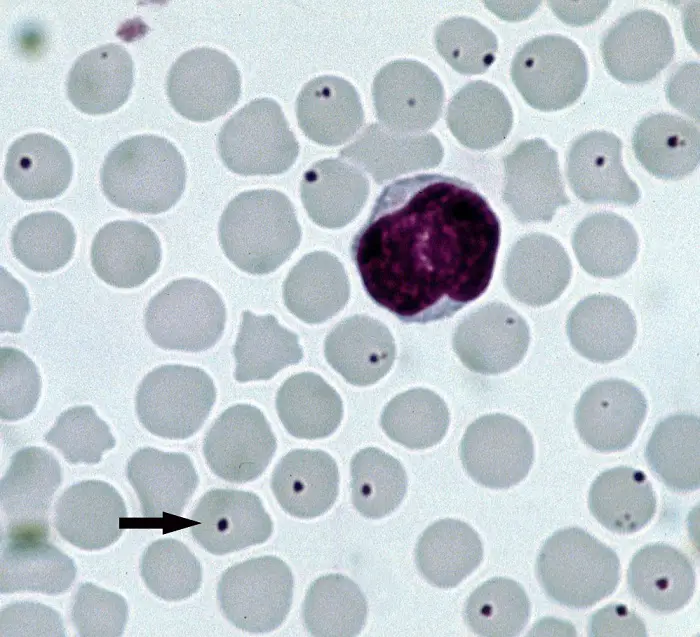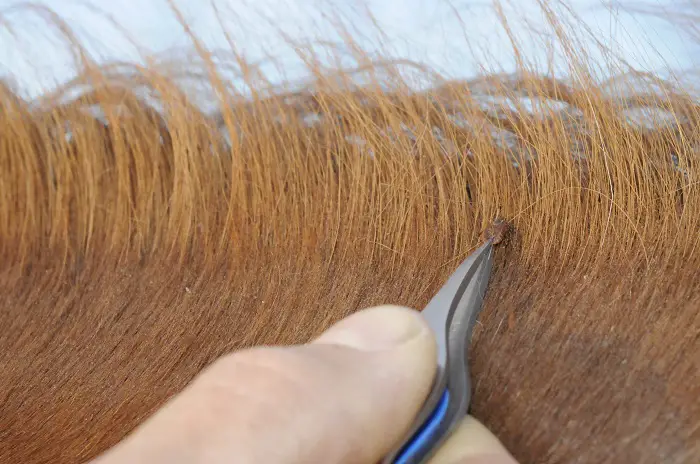Anaplasmosis is a tick-borne disease that affects horses and other mammals. It is caused by the bacterium Anaplasma phagocytophilum, which is transmitted by the bite of infected ticks. Anaplasmosis in horses can cause various symptoms, including fever, lethargy, anorexia, weight loss, lameness, and neurologic signs.
Causes of Anaplasmosis in Horses
Anaplasmosis in horses is caused by the bacterium Anaplasma phagocytophilum, transmitted through infected ticks’ bites. The primary vector for A phagocytophilum is the black-legged tick (Ixodes scapularis), commonly found in areas with high grass or brush, such as wooded areas or fields.
Horses can become infected with A phagocytophilum when bitten by an infected tick. Once inside the horse’s bloodstream, the bacteria infect white blood cells, causing them to clump together and form aggregates, which can then block blood vessels and cause tissue damage. This can lead to various clinical signs, including fever, lethargy, anorexia, weight loss, lameness, and neurologic signs.
While ticks are the primary vector for A phagocytophilum, some evidence suggests that the bacteria can also be spread through blood transfusions. However, this mode of transmission is rare. In some cases, A phagocytophilum may also be transmitted vertically from an infected mare to her foal during pregnancy.
Epidemiology of Equine Anaplasmosis
Equine anaplasmosis is found worldwide and is an emerging disease in many areas. The disease is caused by the bacterium A phagocytophilum, transmitted by infected ticks. The prevalence of equine anaplasmosis can vary depending on factors such as geographic location, tick population density, and environmental conditions.
In the United States, equine anaplasmosis is most commonly reported in the northeastern and upper midwestern regions, where the black-legged tick (I scapularis) is the primary vector. However, the disease has also been reported in other areas, including the western United States, where the western black-legged tick (I pacificus) can serve as a vector.
Horses of all ages and breeds are susceptible to anaplasmosis. Still, the disease is most commonly reported in adult horses during the late summer and early fall, corresponding to infected ticks’ peak activity.
Clinical Signs of Anaplasmosis in Horses
Anaplasmosis in horses can cause various clinical signs varying in severity and duration. Some horses may show no clinical signs, while others may develop severe and potentially life-threatening complications.
The clinical signs of anaplasmosis in horses can include the following:
- Fever: Fever is one of the most common signs of anaplasmosis and can range from mild to severe. The fever may come and go and last several days or weeks.
- Lethargy: Horses with anaplasmosis may become lethargic and show a decreased interest in food and water.
- Anorexia: Horses with anaplasmosis may lose their appetite and show signs of anorexia.
- Weight loss: In severe cases, horses with anaplasmosis may experience weight loss due to the loss of appetite and decreased nutrient intake.
- Lameness: Anaplasmosis can cause lameness, which can be unilateral or bilateral. The lameness may be due to joint inflammation or swelling.
- Neurologic signs: In rare cases, anaplasmosis can cause neurologic signs, such as ataxia, seizures, and circling.
Diagnosis of Equine Anaplasmosis
Diagnosis of equine anaplasmosis typically involves a combination of clinical signs, laboratory tests, and examination of blood smears.
The clinical signs of anaplasmosis in horses can be non-specific and similar to other diseases, such as Lyme disease or Ehrlichiosis, also transmitted by ticks. Therefore, laboratory testing is often necessary to confirm the diagnosis.
Laboratory tests used to diagnose anaplasmosis in horses include:
- Blood Tests: A complete blood count (CBC) may reveal low white blood cell counts, platelet counts, and anemia. A serum chemistry panel may also assess liver and kidney function.
- Serology: A serologic test can detect antibodies to the Anaplasma phagocytophilum bacterium in the horse’s blood.
- PCR (Polymerase Chain Reaction) Testing: PCR can detect the presence of Anaplasma DNA in the horse’s blood.
- Blood Smears: Examination of blood smears under a microscope can reveal the presence of Anaplasma bacteria inside white blood cells, which can confirm the diagnosis.
Treatment of Anaplasmosis in Horses
Treating equine anaplasmosis typically involves using antibiotics, such as tetracycline or doxycycline, and supportive care to manage symptoms. The antibiotics kill the Anaplasma bacteria, reducing the severity and duration of clinical signs.
The duration of antibiotic therapy may vary depending on the severity of the infection and the response to treatment. In some cases, treatment may last for several weeks.
In addition to antibiotics, supportive care may be necessary to manage horses’ clinical signs of anaplasmosis. Supportive care may include:
- Fluid Therapy: Horses with anaplasmosis may become dehydrated due to decreased water intake and increased fluid loss. Fluid therapy can help maintain hydration and electrolyte balance.
- Anti-inflammatory Medications: Non-steroidal anti-inflammatory drugs (NSAIDs), such as phenylbutazone or flunixin meglumine, can help reduce fever, inflammation, and pain associated with anaplasmosis.
- Nutritional Support: Horses with anaplasmosis may experience a loss of appetite and weight. Providing palatable, nutrient-dense feeds can help maintain body condition and support recovery.
- Rest and Supportive Care: Resting the horse and providing a clean, comfortable environment can help minimize stress and support recovery.
Prevention of Equine Anaplasmosis
Preventing anaplasmosis in horses involves reducing exposure to infected ticks and minimizing the risk of infection. Here are some key prevention strategies:
Tick control: Ticks are the primary vector for Anaplasma bacteria, so controlling ticks on horses and in their environment can help reduce the risk of infection. This can be done using topical or systemic tick repellents, removing tall grass and weeds, and keeping horses away from tick-infested areas.
Regular tick checks: Check horses regularly for ticks, particularly in areas where ticks are commonly found, such as the ears, mane, and tail.
Vaccination: No vaccine is currently available for anaplasmosis in horses, but research is ongoing.
Prompt diagnosis and treatment: Early diagnosis and prompt treatment of anaplasmosis can help reduce the severity and duration of clinical signs and prevent the spread of infection.
Quarantine: Horses diagnosed with anaplasmosis should be isolated from other horses to prevent the spread of infection.
Biosecurity measures: Practice suitable biosecurity measures, such as disinfecting equipment and adequately disposing of manure, to help prevent the spread of disease.
Education: Educate horse owners, barn managers, and handlers about anaplasmosis and the importance of tick control and prevention measures.
Concluding Remarks on Anaplasmosis in Horses
Anaplasmosis is a tick-borne disease caused by the bacterium A phagocytophilum that can affect horses. The disease is prevalent in areas with high tick populations, and clinical signs can range from mild to severe, including fever, anorexia, lethargy, and muscle weakness. Anaplasmosis can be diagnosed through clinical signs, laboratory tests, and examination of blood smears.
Treatment typically involves using antibiotics, such as tetracycline or doxycycline, and supportive care to manage symptoms.
Prevention of anaplasmosis in horses involves:
- Tick control and prevention measures.
- Regular tick checks.
- Quarantine of infected horses.
- Education about the disease.
Prompt diagnosis and treatment are essential to managing clinical signs, reducing the risk of complications, and preventing infection from spreading to other horses. With proper prevention and treatment, the prognosis for anaplasmosis in horses is generally reasonable.

